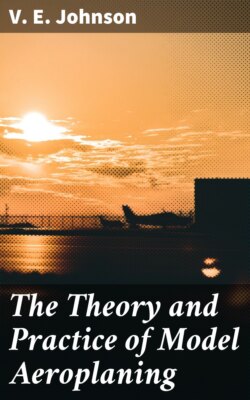Читать книгу The Theory and Practice of Model Aeroplaning - V. E. Johnson - Страница 4
На сайте Литреса книга снята с продажи.
GLOSSARY OF TERMS USED IN
MODEL AEROPLANING.
ОглавлениеTable of Contents
Aeroplane. A motor-driven flying machine which relies upon surfaces for its support in the air.
Monoplane (single). An aeroplane with one pair of outstretched wings.
Aerofoil. These outstretched wings are often called aerofoil surfaces. One pair of wings forming one aerofoil surface.
Monoplane (double). An aeroplane with two aerofoils, one behind the other or two main planes, tandem-wise.
Biplane. An aeroplane with two aerofoils, one below the other, or having two main planes superposed.
Triplane. An aeroplane having three such aerofoils or three such main planes.
Multiplane. Any such machine having more than three of the above.
Glider. A motorless aeroplane.
Helicopter. A flying machine in which propellers are employed to raise the machine in the air by their own unaided efforts.
Dihedral Angle. A dihedral angle is an angle made by two surfaces that do not lie in the same plane, i.e. when the aerofoils are arranged V-shaped. It is better, however, to somewhat extend this definition, and not to consider it as necessary that the two surfaces do actually meet, but would do so if produced thus in figure. BA and CD are still dihedrals, sometimes termed "upturned tips."
Dihedrals.
Span is the distance from tip to tip of the main supporting surface measured transversely (across) the line of flight.
Camber (a slight arching or convexity upwards). This term denotes that the aerofoil has such a curved transverse section.
Chord is the distance between the entering (or leading) edge of the main supporting surface (aerofoil) and the trailing edge of the same; also defined as the fore and aft dimension of the main planes measured in a straight line between the leading and trailing edges.
Aspect Ratio is span/chord
Gap is the vertical distance between one aerofoil and the one which is immediately above it.
(The gap is usually made equal to the chord).
Angle of Incidence. The angle of incidence is the angle made by the chord with the line of flight.
| AB = chord. | AB = cambered surface. |
| SP = line of flight. | ASP = α = L of incidence. |
Width. The width of an aerofoil is the distance from the front to the rear edge, allowing for camber.
Length. This term is usually applied to the machine as a whole, from the front leading edge of elevator (or supports) to tip of tail.
Arched. This term is usually applied to aerofoil surfaces which dip downwards like the wings of a bird. The curve in this case being at right angles to "camber." A surface can, of course, be both cambered and arched.
Propeller. A device for propelling or pushing an aeroplane forward or for raising it vertically (lifting screw).
Tractor Screw. A device for pulling the machine (used when the propeller is placed in the front of the machine).
Keel. A vertical plane or planes (usually termed "fins") arranged longitudinally for the purposes of stability and steering.
Tail. The plane, or group of planes, at the rear end of an aeroplane for the purpose chiefly of giving longitudinal stability. In such cases the tail is normally (approx.) horizontal, but not unfrequently vertical tail-pieces are fitted as well for steering (transversely) to the right or left, or the entire tail may be twisted for the purpose of transverse stability (vide Elevator). Such appendages are being used less and less with the idea of giving actual support.
Rudder is the term used for the vertical plane, or planes, which are used to steer the aeroplane sideways.
Warping. The flexing or bending of an aerofoil out of its normal shape. The rear edges near the tips of the aerofoil being dipped or tilted respectively, in order to create a temporary difference in their inclinations to the line of flight. Performed in conjunction with rudder movements, to counteract the excessive action of the latter.
Ailerons (also called "righting-tips," "balancing-planes," etc.). Small aeroplanes in the vicinity of the tips of the main aerofoil for the purpose of assisting in the maintenance of equilibrium or for steering purposes either with or without the assistance of the rudder.
Elevator. The plane, or planes, in front of the main aerofoil used for the purpose of keeping the aeroplane on an even keel, or which cause (by being tilted or dipped) the aeroplane to rise or fall (vide Tail).
